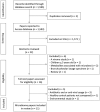Respiratory tract infections and gut microbiome modifications: A systematic review
- PMID: 35025938
- PMCID: PMC8757905
- DOI: 10.1371/journal.pone.0262057
Respiratory tract infections and gut microbiome modifications: A systematic review
Abstract
Respiratory tract infections (RTIs) are extremely common and can cause gastrointestinal tract symptoms and changes to the gut microbiota, yet these effects are poorly understood. We conducted a systematic review to evaluate the reported evidence of gut microbiome alterations in patients with a RTI compared to healthy controls (PROSPERO: CRD42019138853). We systematically searched Medline, Embase, Web of Science, Cochrane and the Clinical Trial Database for studies published between January 2015 and June 2021. Studies were eligible for inclusion if they were human cohorts describing the gut microbiome in patients with an RTI compared to healthy controls and the infection was caused by a viral or bacterial pathogen. Dual data screening and extraction with narrative synthesis was performed. We identified 1,593 articles and assessed 11 full texts for inclusion. Included studies (some nested) reported gut microbiome changes in the context of Severe Acute Respiratory Syndrome Coronavirus 2 (SARS-CoV-2) (n = 5), influenza (H1N1 and H7N9) (n = 2), Tuberculosis (TB) (n = 4), Community-Acquired Pneumonia CAP (n = 2) and recurrent RTIs (rRTI) (n = 1) infections. We found studies of patients with an RTI compared to controls reported a decrease in gut microbiome diversity (Shannon) of 1.45 units (95% CI, 0.15-2.50 [p, <0.0001]) and a lower abundance of taxa (p, 0.0086). Meta-analysis of the Shannon value showed considerable heterogeneity between studies (I2, 94.42). Unbiased analysis displayed as a funnel plot revealed a depletion of Lachnospiraceae, Ruminococcaceae and Ruminococcus and enrichment of Enterococcus. There was an important absence in the lack of cohort studies reporting gut microbiome changes and high heterogeneity between studies may be explained by variations in microbiome methods and confounder effects. Further human cohort studies are needed to understand RTI-induced gut microbiome changes to better understand interplay between microbes and respiratory health.
Conflict of interest statement
The authors have declared no competing interests exist.
Figures



References
-
- WHO covid-19 dashboard. 2020; https://covid19.who.int/?gclid=CjwKCAiA_eb-BRB2EiwAGBnXXiTJC9zp-D8v1G3Ou....
Publication types
MeSH terms
Grants and funding
LinkOut - more resources
Full Text Sources
Miscellaneous

